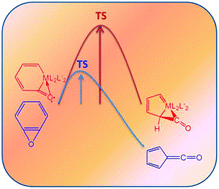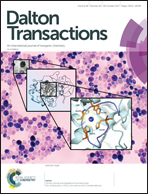Ring contraction of metallabenzooxirene to metal carbonyl complexes – a comparative study with the Wolff rearrangement of oxirene and benzooxirene†
Abstract
A detailed quantum mechanical study on the role of transition metal fragments towards the epoxidation reaction of metallabenzynes (1M, M = Fe, Ru, Os) to give metallabenzyne epoxide or metallabenzooxirene (2M), followed by the Wolff type 1,2-rearrangement to give metal carbonyls (4M), has been carried out at the M06/def2-TZVPP//BP86/def2-SVP level of theory. The epoxide or oxirene product (2A) of linear alkynes like acetylene is unstable and converts to a ketene (4A) by highly exothermic (−78.7 kcal mol−1) Wolff rearrangement via an oxocarbene (3A) intermediate. The epoxide product of cyclic alkynes like benzyne (2C) is comparatively more stable than benzooxocarbene (3C), yet it undergoes rearrangement to cyclopentadienylketene (4C) through Wolff type ring contraction reactions (−65.3 kcal mol−1). The replacement of one of the carbyne carbons in benzyne by 14 VE metal fragment M(PH3)2Cl2, M = Fe, Ru and Os enhances the stability of the 18 VE metallabenzyne epoxide product (2M, −88.1 kcal mol−1 for 2Fe, −87.2 kcal mol−1 for 2Ru and −82.8 kcal mol−1 for 2Os) as compared to the 16 VE metallacyclohexadienone (3M). The ring contracted 18 VE product of 2M is a carbonyl bridged metallacyclopentadienyl complex (4M, M = Fe, Ru and Os). Even though this interconversion is thermodynamically favourable, it involves a high-energy barrier (19.3, 28.1 and 27.9 kcal mol−1 for 2Fe, 2Ru and 2Os, respectively). However, the hepta-coordinated (5M) terminal metallacyclopentadienyl carbonyl analogues of ketene (4A/4C) are not minima on the potential energy surface.



 Please wait while we load your content...
Please wait while we load your content...